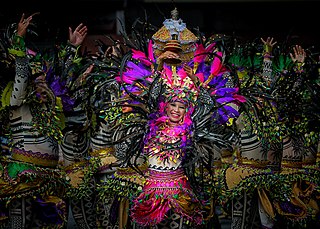Related Research Articles

Albert Camus was a French philosopher, author, dramatist, journalist, world federalist, and political activist. He was the recipient of the 1957 Nobel Prize in Literature at the age of 44, the second-youngest recipient in history. His works include The Stranger, The Plague, The Myth of Sisyphus, The Fall and The Rebel.
A tutelary is a deity or a spirit who is a guardian, patron, or protector of a particular place, geographic feature, person, lineage, nation, culture, or occupation. The etymology of "tutelary" expresses the concept of safety and thus of guardianship.

Swazi culture is the way of life and customs of the Swazi people through various historical stages. The culture of Swazi people involves music, food, religion, architecture, and kinship, among many other things. The Swazi people are composed of various Nguni clans who speak the Nguni language siSwati. These people mostly reside in Eswatini and South Africa. Presently, Swazi people may also include citizens of Eswatini. In Eswatini, one of the most visible features of cultural identity is the traditional political structure of the nation and the home. In the national level, the Ngwenyama is considered the head of the nation alongside the Ndlovukati who is the spiritual leader of the nation. National cultural events often involve the Ngwenyama or Ndlovukati. At home, the patriarch of the family is the head and often practices polygamy. This headman, usually referred to as umnumzane is central to all activities of the home. A group of homes forming a community and the land they reside on forms a chiefdom or umphakatsi. Several chiefdoms form an inkhundla which then belongs of a regional division of the country. This connects the older traditional leadership structures to more modern forms of government.

The Sinulog-Santo Niño Festival is an annual cultural and religious festival held on the third Sunday of January in Cebu, with the center of the activities being in Cebu City, and is the centre of the Santo Niño Christian celebrations in the Philippines.
Exile and the Kingdom is a 1957 collection of six short stories by French writer Albert Camus. First published in French, in translation, it was not well received by contemporary English critics. The underlying theme of these stories is human loneliness and feeling foreign and isolated in one's own society. Camus writes about outsiders living in Algeria who straddle the divide between the Muslim world and France.

Genevieve was a consecrated virgin, and is the patron saint of Paris in the Catholic and Orthodox traditions. Her feast day is on 3 January.

Black Orpheus is a 1959 romantic tragedy film directed by French filmmaker Marcel Camus and starring Marpessa Dawn and Breno Mello. It is based on the play Orfeu da Conceição by Vinicius de Moraes, which set the Greek legend of Orpheus and Eurydice in a contemporary favela in Rio de Janeiro during Carnaval. The film was an international co-production among companies in Brazil, France and Italy.

A procession is an organized body of people walking in a formal or ceremonial manner.

Königskinder is a stage work by Engelbert Humperdinck that exists in two versions: as a melodrama and as an opera or more precisely a Märchenoper. The libretto was written by Ernst Rosmer, adapted from her play of the same name.

The Kandy Esala Perahera also known as The Festival of the Tooth is a festival held in July and August in Kandy, Sri Lanka. This historical procession is held annually to pay homage to the Sacred Tooth Relic of Buddha housed at the Sri Dalada Maligawa in Kandy. A unique symbol of Sri Lanka, the procession consists of traditional local dances such as fire dances and performances in whip-dance garments. The festival ends with the traditional Diya-kepeema ritual, a water cutting ceremony which is held at the Mahaweli River at Getambe, Kandy.

Quyllurit'i or Qoyllur Rit'i is a syncretic religious festival held annually at the Sinakara Valley in the southern highlands Cusco Region of Peru. Local indigenous people of the Andes know this festival as a native celebration of the stars. In particular they celebrate the reappearance of the Pleiades constellation, known in Quechua as Qullqa, or "storehouse," and associated with the upcoming harvest and New Year. The Pleiades disappears from view in April and reappears in June. The new year is marked by indigenous people of the Southern Hemisphere on the Winter Solstice in June, and it is also a Catholic festival. The people have celebrated this period of time for hundreds if not thousands of years. The pilgrimage and associated festival was inscribed in 2011 on the UNESCO Intangible Cultural Heritage Lists.
Bengaluru Karaga is an annual festival celebrated in the Tigalare Pete, primarily by the Vahnikula Kshatriya or Thigala community. Based on story of their heritage, they built temples for Draupadi and Dharmaraya (Yudhishthira). Adishakti Draupadi is the community Deity of the Vahnikula Kshatriyas, one of the foremost communities in Karanataka state. The Dharmaraya Swamy Temple itself is more than 800 years old. It was built by the Vahnikula Kshatriyas, one of the city's oldest communities that was into agriculture and horticulture. The Karaga festival is generally led by the Vahnikula Kshatriyas. Karaga is one of the many traditions of worshiping Adisakti Draupadi Devi. Karaga pooja and festivals have been celebrated in Tamil Nadu and Karnataka since ages. Its practice is in use in some parts of Kolar district and Bangalore in the state of Karnataka. It is learnt that there are forty lakh people belonging to the Vahnikula Kshatriya community living throughout the state: Hoskote, Malur, Kolar, Bengaluru and Anekal taluks have high populations of the Vahnikula Kshatriya community in both urban and rural areas. Basically, this community depends upon agricultural and horticultural activities.

A funeral procession is a procession, usually in motor vehicles or by foot, from a funeral home or place of worship to the cemetery or crematorium. In earlier times the deceased was typically carried by male family members on a bier or in a coffin to the final resting place. This practice has shifted over time toward transporting the deceased in a hearse, while family and friends follow in their vehicles. The transition from the procession by foot to procession by car can be attributed to two main factors; the switch to burying or cremating the body at locations far from the funeral site and the introduction of motorized vehicles and public transportation making processions by foot through the street no longer practical.

Holy Week is a significant religious observance in the Philippines for the Catholic majority, the Iglesia Filipina Independiente or the Philippine Independent Church, and most Protestant groups. One of the few majority Christian countries in Asia, Catholics make up 78.8 percent of the country's population, and the Church is one of the country's dominant sociopolitical forces.

Pope Night was an anti-Catholic holiday celebrated annually on November 5 in the colonial United States. It evolved from the British Guy Fawkes Night, which commemorates the failure of the Gunpowder Plot of 1605. Pope Night was most popular in the seaport towns of New England, especially in Boston, where it was an occasion for drinking, rioting, and anti-elite protest by the working class.

Indra Jātrā, also known as Yenyā Punhi is the biggest religious street festival in Kathmandu, Nepal. "Ye" means the old Newari name for "Kathmandu", "Ya" means “Celebration”, and "Puhni" means full moon so together means the birthday of the old city of Kathmandu. The celebrations consist of two events, Indra Jātrā and Kumāri Jātrā. Indra Jātrā is marked by masked dances of deities and demons, displays of sacred images, and tableaus in honor of the deity Indra, the king of heaven. Kumāri Jātrā is the chariot procession of the living goddess Kumari.

Our Lady of the Most Holy Rosary, Queen of the Caracol, known locally as Mahal na Birhen ng Santo Rosaryo, Reyna ng Karakol or Nuestra Señora Virgen del Santisimo Rosario, Reina del Caracol, is the patroness of the Municipality of Rosario, formerly known as Salinas, in Cavite province, Philippines.

Vattisen Yaly is a contemporary revival of the ethnic religion of the Chuvash people, a Turkic ethnicity of Bulgar ancestry mostly settled in the republic of Chuvashia and surrounding federal subjects of Russia.

Yemọja is the major water spirit from the Yoruba religion. She is the mother of all Orishas. She is also the mother of humanity. She is an orisha, in this case patron spirit of rivers, particularly the Ogun River in Nigeria, and oceans in Cuban and Brazilian orisa religions. She is often syncretized with either Our Lady of Regla in the Afro-Cuban diaspora or various other Virgin Mary figures of the Catholic Church, a practice that emerged during the era of the Trans-Atlantic slave trade. Yemọja is said to be motherly and strongly protective, and to care deeply for all her children, comforting them and cleansing them of sorrow. She is said to be able to cure infertility in women, and cowrie shells represent her wealth. She does not easily lose her temper, but when angered she can be quite destructive and violent, as the flood waters of turbulent rivers. Some of the priests of Yemọja believe that she used her fresh water to help Ọbàtálá in the molding of human beings out of clay.

In Taxco, the processions and ceremonies of Holy Week are elaborate and have gained international fame. Between Palm Sunday and Easter Sunday, there are ten major processions, six during the evening and four during the day. Most processions are about two and a half kilometers long and take about two hours to complete. These commemorations date back to at least 1622 when they were begun in the atrium of the Church of the Ex monastery of San Bernardino de Siena. Now these processions and ceremonies center of the Santa Prisca Church.
References
- ↑ COHN, R. G (1988). "Camus's Sacred: The Growing Stone in Language, Religion, Culture". Camus's Sacred: The Growing Stone in Language, Religion, Culture. 5 (1–2): 151–160. ISSN 0886-666X.
- ↑ Mellon, Linda Forge (1991). "An Archetypal Analysis of Albert Camus's "La Pierre qui pousse": The Quest as Process of Individuation". The French Review. 64 (6): 934–944. ISSN 0016-111X. JSTOR 396087.